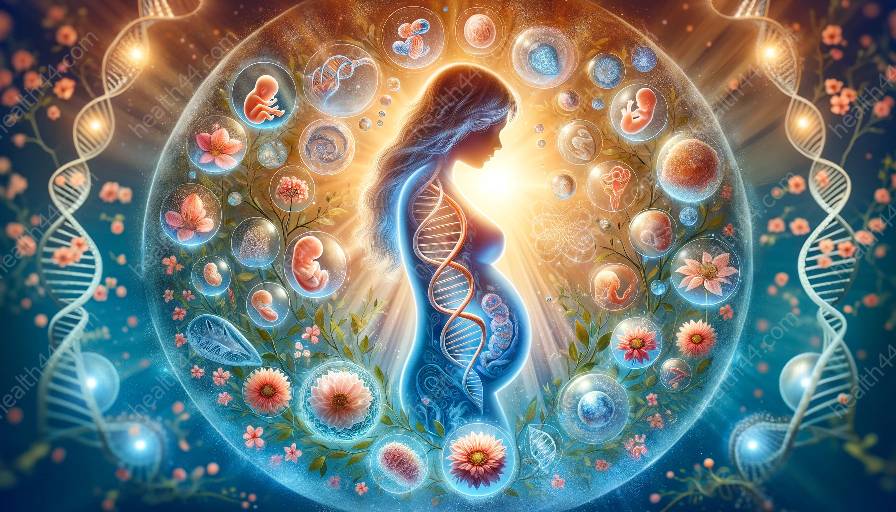The process of placental development and its function in fetal circulation plays a critical role in supporting the growing fetus. Understanding the intricacies of fetal circulation enhances our knowledge of the complexities involved in fetal development. In this comprehensive guide, we will delve into the fascinating world of placental development, its function in fetal circulation, and its connection to fetal development.
Understanding Fetal Circulation
Fetal circulation refers to the circulatory system of a developing fetus. In the early stages of fetal development, the exchange of oxygen, nutrients, and waste products occurs through the placenta. The unique structure and function of the placenta are essential for ensuring the well-being and growth of the fetus. As the fetus develops, the placenta undergoes a series of developmental changes to meet the increasing demand for nutrients and oxygen.
Placental Development
Placental development is a complex and dynamic process that begins early in pregnancy. The placenta is formed from maternal and fetal tissues and serves as the interface through which maternal and fetal circulatory systems interact. Development of the placenta involves intricate changes in the structure and function of the maternal-fetal interface and is crucial for supporting fetal growth and development.
Formation of the Placenta
During implantation, the blastocyst attaches to the uterine wall, and the trophoblast, the outer layer of the blastocyst, begins to develop into the placenta. The trophoblast differentiates into two distinct layers: the cytotrophoblast and the syncytiotrophoblast. These layers play essential roles in facilitating the exchange of nutrients, gases, and waste products between the maternal and fetal circulatory systems.
Vascularization
As the placenta develops, it undergoes a phase of extensive vascularization. This process involves the formation of a network of blood vessels that enables the exchange of gases, nutrients, and waste products. The intricate network of blood vessels in the placenta ensures efficient transfer of substances between the maternal and fetal circulatory systems.
Functional Adaptations
Throughout gestation, the placenta undergoes functional adaptations to meet the changing needs of the developing fetus. These adaptations include adjustments in blood flow, nutrient transport, and hormone production to support fetal growth and maturation.
Function in Fetal Circulation
The placenta plays a pivotal role in fetal circulation by ensuring the delivery of oxygen and nutrients to the developing fetus and removing waste products. The unique structure of the placenta and its close association with the maternal circulation allow for the efficient exchange of substances required for fetal development.
Gas Exchange
One of the primary functions of the placenta in fetal circulation is the exchange of gases. Oxygen from the maternal blood diffuses into the fetal circulation through the placenta, while carbon dioxide and other waste products are transported from the fetal circulation to the maternal blood for elimination.
Nutrient Transport
The placenta serves as a conduit for the transfer of essential nutrients from the maternal circulation to the fetal circulation. Nutrients such as glucose, amino acids, fatty acids, and vitamins are transported across the placenta to support the metabolic needs of the developing fetus.
Waste Removal
In addition to nutrient transport, the placenta facilitates the removal of waste products from the fetal circulation. Metabolic waste substances are transferred from the fetal circulation to the maternal circulation for elimination, ensuring the maintenance of a healthy intrauterine environment.
Significance for Fetal Development
The interplay between placental development, its function in fetal circulation, and fetal development is of paramount importance. The placenta serves as the lifeline for the developing fetus, providing essential support for growth, organogenesis, and overall maturation.
Hormonal Regulation
In addition to its role in nutrient and gas exchange, the placenta produces hormones that play crucial roles in regulating fetal development. Hormones such as human chorionic gonadotropin (hCG), estrogen, progesterone, and others are essential for maintaining pregnancy and supporting the development of fetal organs and systems.
Impact on Organogenesis
Proper placental development and function are essential for ensuring the normal development of fetal organs. Adequate oxygen and nutrient supply facilitated by the placenta are critical for the formation and maturation of vital organs, including the brain, heart, liver, and kidneys.
Adaptations in Late Pregnancy
As pregnancy progresses, the placenta undergoes further adaptations to meet the increasing demands of the growing fetus. Changes in placental blood flow, nutrient transport, and endocrine function occur to support the exponential growth and development of the fetus, highlighting the dynamic nature of placental development and its function in fetal circulation.
Conclusion
The intricate process of placental development and its function in fetal circulation is a captivating and essential aspect of fetal development. Understanding the complexities of fetal circulation and its interrelationship with placental development deepens our appreciation for the remarkable mechanisms that support the growth and development of the fetus. Through a closer examination of the intricate dance between the placenta, fetal circulation, and fetal development, we gain valuable insights into the wondrous journey of prenatal life.


